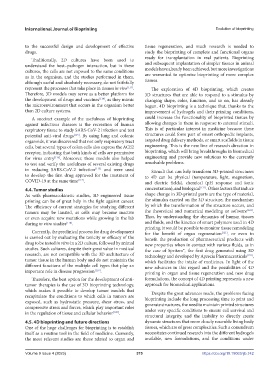Page 383 - IJB-9-4
P. 383
International Journal of Bioprinting Evolution of bioprinting
to the successful design and development of effective tissue regeneration, and much research is needed to
drugs. study the bioprinting of complete and functional organs
Traditionally, 2D cultures have been used to ready for transplantation in real patients. Bioprinting
understand the host–pathogen interaction, but in these and subsequent implantation of simpler tissues in animal
cultures, the cells are not exposed to the same conditions models have already been achieved, but more investigations
as in the organism, and the studies performed in them, are warranted to optimize bioprinting of more complex
although useful and absolutely necessary, do not faithfully tissues.
represent the processes that take place in tissues in vivo [113] . The exploration of 4D bioprinting, which creates
Therefore, 3D models may serve as a better platform for 3D structures that are able to respond to a stimulus by
the development of drugs and vaccines [114] , as they mimic changing shape, color, function, and so on, has already
the microenvironment that occurs in the organism better begun. 4D bioprinting is a technique that, thanks to the
than 2D culture systems. improvement of hydrogels and their printing conditions,
A succinct example of the usefulness of bioprinting could increase the functionality of bioprinted tissues by
against infectious diseases is the recreation of human allowing changes in them in response to external stimuli.
respiratory tissue to study SARS-CoV-2 infection and test This is of particular interest in medicine because these
potential anti-viral drugs [115] . By using lung and colonic structures could form part of smart orthopedic implants,
organoids, it was discovered that not only respiratory tract targeted drug delivery methods, or smart scaffolds in tissue
cells, but several types of colon cells also express the ACE2 engineering. This is the new line of research direction in
receptor, indicating that both kinds of cells are permissive bioprinting, which will bring breakthroughs in biomedical
for virus entry [116] . Moreover, these models also helped engineering and provide new solutions to the currently
to test and verify the usefulness of several existing drugs unsolvable problems.
in reducing SARS-CoV-2 infection [115] and were used Stimuli that can help transform 3D-printed structures
to develop the first drug approved for the treatment of to 4D can be physical (temperature, light, magnetism,
COVID-19 at the same time [117] . and electric fields), chemical (pH response and ionic
4.4. Tumor studies concentration), and biological [121] . Other factors that induce
As with pharmacokinetic studies, 3D engineered tissue shape change in 3D-printed parts are the type of material,
printing can be of great help in the fight against cancer. the stimulus exerted on the 3D structure, the mechanism
The efficiency of current strategies for studying different by which the transformation of the structure occurs, and
tumors may be limited, as cells may become inactive the theoretical and numerical modeling or software [122] .
or even acquire new mutations while growing in the lab Thus, by understanding the dynamics of human tissues
during in vitro studies [118] . and fluids, and the kinetics of smart polymers used in 4D
printing, it would be possible to monitor tissue remodeling
Currently, the preclinical process for drug development for the benefit of organ regeneration [121] , or even to
is carried out by evaluating the toxicity or efficacy of the benefit the production of pharmaceutical products with
drug to be tested in vitro in a 2D culture, followed by animal new properties when in contact with various fluids, as in
studies. Such cultures, despite their great value in medical the case of Spritam®, the first drug generated using 3D
research, are not compatible with the 3D architecture of technology and developed by Aprecia Pharmaceuticals [123] ,
tumor tissue in the human body and do not maintain the which facilitates the intake of medicines. In light of the
different functions of the multiple cell types that play an new advances in this regard and the possibilities of 4D
important role in disease progression [119] . printing in organ and tissue regeneration and new drug
Therefore, the best option for the development of anti- formulations, the concept of 4D printing represents a new
tumor therapies is the use of 3D bioprinting technology, approach for biomedical applications.
which makes it possible to develop tumor models that Despite the great advances made, the problems facing
recapitulate the conditions to which cells in tumors are bioprinting include the long processing time to print and
exposed, such as hydrostatic pressure, shear stress, and generate structures, the need to maintain printed structures
compressive stress and forces, which play important roles under very specific conditions to ensure cell survival and
in the regulation of tissue and cellular behavior [120] .
structural integrity, and the inability to directly create
4.5. 4D bioprinting and future directions dynamic structures that more closely resemble living body
One of the huge challenges for bioprinting is to establish tissues, which are of great complexities. Such a conundrum
itself as a routine tool in the field of medicine. Currently, necessitates continued research into the different hydrogels
the most relevant studies are those related to organ and available, new formulations, and the conditions under
Volume 9 Issue 4 (2023) 375 https://doi.org/10.18063/ijb.742

